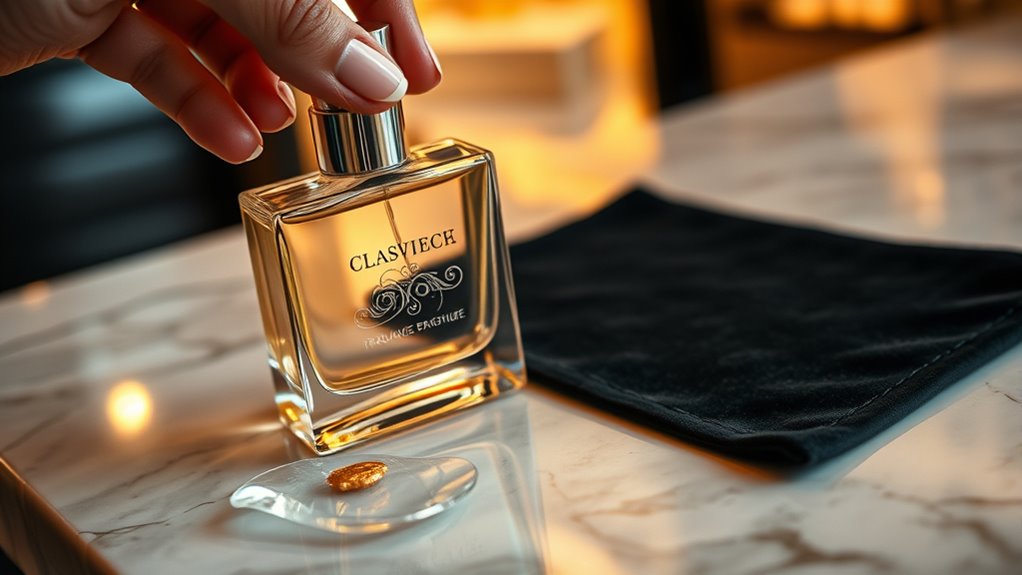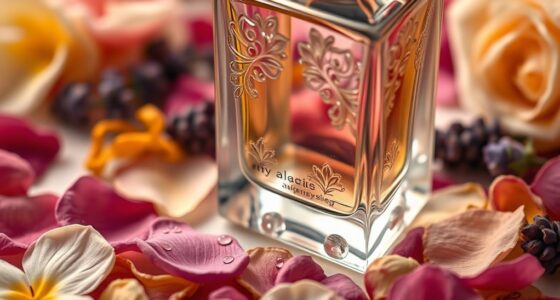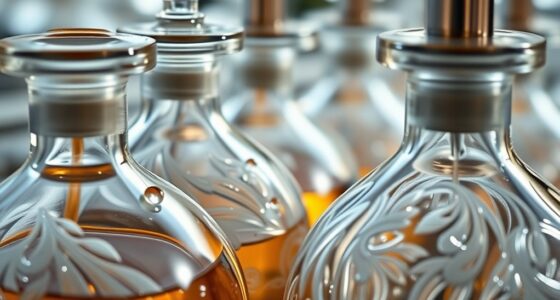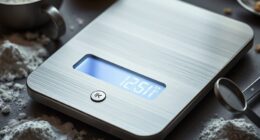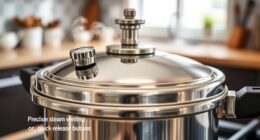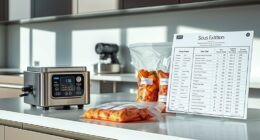To sample perfume like a pro, start by using small spritzes on warm areas like your wrists or elbows, allowing the scent to settle. Try scent layering with tiny amounts of different fragrances for a complex feel and observe how each note evolves over time. Store your bottles properly in a cool, dark place to keep their integrity. Pay attention to environmental factors and develop your evaluation skills—if you continue exploring, you’ll master the art of scent assessment.
Key Takeaways
- Use small spritzes on warm skin areas like wrists or inner elbows for better scent development.
- Engage in scent layering by combining small amounts of different fragrances to explore complex profiles.
- Store perfumes properly in cool, dark places to preserve their true aroma before testing.
- Wait a few moments after applying to let the fragrance settle and reveal all notes.
- Evaluate scents under different lighting and environmental conditions to assess performance and evolution.

Ever wondered how to sample perfume like a pro? It’s all about understanding how different scents interact and making the most of your testing process. When you’re exploring new fragrances, scent layering can be a game-changer. Rather than sticking to just one perfume, try combining small amounts of different scents on your skin to see how they blend over time. This technique helps you discover complex fragrances that might not reveal their full character when sampled alone. Layering also gives you a better sense of how perfumes will evolve throughout the day, especially if you prefer more personalized scents.
To truly enjoy the process, proper perfume storage is essential. Keep your bottles in a cool, dark place away from direct sunlight and temperature fluctuations. This preserves the integrity of the fragrance, ensuring that each sample you try is true to its original scent. When you store your perfumes correctly, you avoid changes in aroma that can occur with exposure to heat or light, helping you make more accurate judgments during your sampling sessions. It’s a simple step that markedly enhances your ability to identify scents you genuinely love.
When you’re testing perfumes, start with small spritzes on your wrist or the inside of your elbow—areas where your skin is warm and can help amplify the fragrance. Wait a few moments before sniffing to allow the perfume to settle and reveal its top, middle, and base notes. Engaging all your senses is key; pay attention not just to the scent itself but also to how it makes you feel and how it interacts with your skin chemistry. If you’re serious about finding your signature scent, consider testing fragrances at different times of day or in various environments, as your perception can change depending on context. Additionally, understanding contrast ratio can help you better evaluate how well a perfume performs across different lighting conditions, enhancing your overall sampling strategy.
Frequently Asked Questions
How Long Should I Wait Between Sampling Different Perfumes?
You should wait at least 15 to 20 minutes between sampling different perfumes. This allows your skin to fully absorb each scent, preventing overlap that can skew your perception. During this time, you can explore scent layering or fragrance pairing ideas, which help you understand how perfumes evolve. Giving your skin a breather guarantees you truly appreciate each fragrance’s unique notes without interference from previous samples.
Can I Mix Different Perfume Samples to Create a New Scent?
Yes, you can mix perfume samples to create a new scent through perfume blending and scent layering. Start by choosing complementary fragrances and testing small amounts together on your skin or a scent strip. Experiment with different combinations, adjusting the ratios to find a harmonious blend. Remember, blending is an art, so trust your nose and have fun exploring unique scent profiles that reflect your personal style.
What Are the Best Storage Tips for Perfume Samples?
To keep your perfume samples fresh, focus on proper perfume bottle care and use sample storage containers that protect from light and air. Store them in a cool, dark place, away from humidity and temperature fluctuations. Always make certain lids are tightly sealed to prevent evaporation. Using small, airtight sample storage containers helps preserve the scent and makes it easy to organize your collection, keeping your perfume samples in top condition.
How Can I Tell if a Perfume Sample Is Expired?
You can tell if a perfume sample has expired by checking for scent deterioration, which often indicates it’s past its perfume shelf life. If the fragrance smells sour, off, or has a drastic change in aroma, it’s a sign it’s no longer good to use. Additionally, look for discoloration or changes in consistency. Expired perfumes typically lose their original scent and may develop an unpleasant odor.
Should I Sample Perfumes on Skin or Paper First?
Jump right in and sample perfumes on your skin first, as it shows true scent absorption and helps you understand how it evolves. This method also allows for allergy testing, preventing any surprises later. Paper can be helpful for a quick sniff, but it doesn’t tell you how a perfume reacts with your body chemistry. Trust your nose and let your instincts guide you—sometimes, you’ve got to go with your gut.
Conclusion
Now that you know the secrets to sampling perfume like a pro, you’re ready to uncover scents that truly resonate with your soul. Think of each fragrance as a whispered invitation from a world of elegance and mystery, waiting to embrace your senses. Trust your instincts, explore with curiosity, and let your nose be your guide on this fragrant journey. With these tips, you’ll turn every scent test into a symphony of sophistication.
